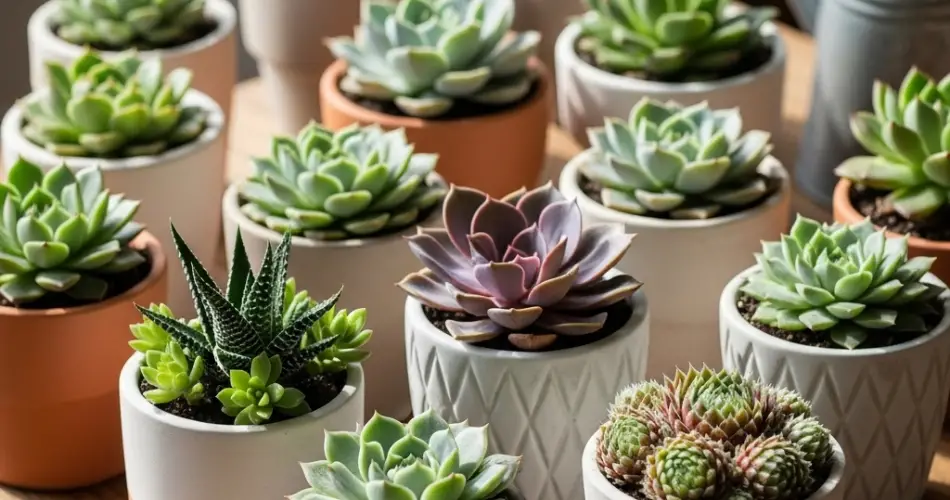Succulents are celebrated for their sculptural beauty, vibrant hues, and versatility in indoor and outdoor gardens. Beyond individual plants, the art of pairing succulents—combining different species based on color, texture, and shape—creates visually striking arrangements that elevate any space. Thoughtful combinations highlight contrasts, harmonize tones, and add depth, turning a simple planter into a living work of art. Understanding the principles of succulent pairing helps gardeners design arrangements that are both beautiful and sustainable.
Understanding Color Combinations
Color is one of the most impactful elements when pairing succulents:
-
Complementary colors: Use colors opposite each other on the color wheel, such as deep green with rich burgundy or pale blue with warm pink. Complementary pairings create vibrant, eye-catching displays.
-
Analogous colors: Combine colors that are next to each other on the color wheel, like green, teal, and soft blue. These combinations provide a harmonious and soothing effect.
-
Neutral tones: Succulents with muted greens, grays, or silvers act as versatile backdrops, allowing brighter-colored varieties to stand out.
Experimenting with color allows gardeners to achieve either bold contrasts or subtle, cohesive compositions.
Mixing Textures for Visual Interest
Texture adds depth and tactile appeal to succulent arrangements:
-
Smooth and glossy leaves: Plants like Echeveria or Graptopetalum have sleek, fleshy leaves that reflect light and create a polished appearance.
-
Rough or ridged leaves: Succulents such as Haworthia or Gasteria have textured, patterned foliage that adds character and complexity.
-
Trailing vs. upright growth: Trailing succulents, like Senecio or String-of-Pearls, contrast beautifully with upright rosettes, adding movement and dimension to a planter.
Combining different textures creates a layered look that captures attention and keeps arrangements from appearing flat or monotonous.
Considering Shapes and Growth Patterns
The form of each succulent influences how it interacts with others in an arrangement:
-
Rosettes: Compact rosettes like Sempervivum or Echeveria serve as focal points and anchor the composition.
-
Columnar and upright forms: Tall varieties, such as Crassula ‘Buddha’s Temple’ or Aloe, provide height and vertical interest.
-
Creeping or trailing types: These are perfect for cascading over edges of containers, softening the arrangement’s boundaries and creating a dynamic visual flow.
Balancing shapes and growth patterns ensures that each plant has space to thrive while maintaining an aesthetically pleasing composition.
Tips for Successful Succulent Pairing
Creating a cohesive arrangement involves more than just visual appeal:
-
Light requirements: Group succulents with similar light needs to prevent weak growth or color fading.
-
Watering needs: Combine plants with comparable watering requirements to avoid overwatering or underwatering individual species.
-
Potting mix: Use a well-draining soil that supports all included species, often a cactus or succulent mix amended with sand or perlite.
-
Container choice: Choose a container with drainage holes and consider its size relative to the plants’ growth potential. Shallow containers work well for rosettes, while deeper pots suit taller or trailing varieties.
Adhering to these guidelines ensures both the health and longevity of your succulent arrangement.
Creative Pairing Ideas
-
Color-focused arrangements: Pair red-tipped Echeveria with soft green Graptopetalum and grayish-blue Senecio for a bold, harmonious palette.
-
Texture contrasts: Mix glossy rosettes with spiky Haworthia and velvety Kalanchoe leaves to create a tactile, visually engaging planter.
-
Height variation: Place a tall Crassula in the center, surrounded by medium-height rosettes and trailing Sedum along the edges for a layered composition.
-
Miniature gardens: Use small containers to create tiny landscapes with varied succulents that mimic natural desert scenes or rock gardens.
Experimenting with different combinations allows gardeners to develop their own unique style.
Maintaining Paired Succulent Arrangements
Once arranged, proper care keeps the composition vibrant and healthy:
-
Sunlight: Provide bright, indirect light to preserve colors and encourage compact growth.
-
Watering: Follow a consistent “soak and dry” routine, ensuring soil dries between waterings.
-
Pruning and propagation: Remove any damaged leaves and propagate offsets to maintain fullness and balance in the arrangement.
Regular maintenance ensures your succulent pairings remain attractive and thriving.
Final Thoughts
The art of succulent pairing combines horticultural knowledge with creative design. By thoughtfully mixing colors, textures, and shapes, gardeners can create arrangements that are visually captivating and harmonious. Considering light, water, and soil needs ensures that the plants not only look beautiful but also thrive together. Whether for indoor decor, patio displays, or miniature gardens, well-paired succulents transform ordinary planters into living works of art, offering endless opportunities for creativity and expression.



